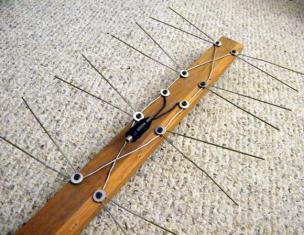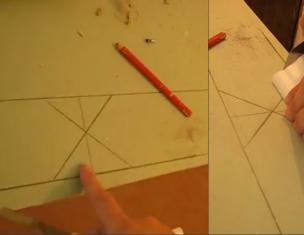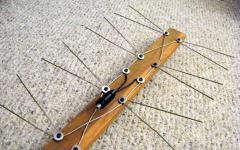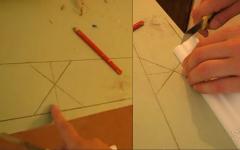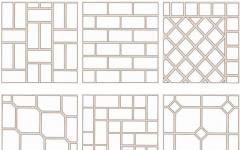To obtain a perfectly smooth wall surface, the alignment of lighthouses is used as one of the ways of this type of work. Despite all the simplicity of the process, there are nuances here, which you need to know.
A set of necessary tools
To carry out these work, you will need:
- Perforator;
- Adapter for stirring the construction mixture;
- Rigs;
- Self-tapping screws with a rare step;
- Screwdriver or cross screwdriver;
- Bubble level 2.5 m.;
- Bulgarian or scissors for metal;
- Plumb;
- A hammer;
- Aluminum rule 2.5 m.;
- Wide 15-centimeter spatula;
- Ironing;
- Roulette;
- Bucket;
- Stood steel;
- Construction gloves;
- Roulette.
Surface preparation
Dismantling of old plaster
Before starting the main work, it is necessary to conduct preparatory. First of all, it is necessary to get rid of the old plaster.
If you think this stage is not needed to cover the hammer each square centimeter of the surface to beat the detached old plaster. If such places are found, it is completely removed.
Dry broomat off the entire surface, cleaning it from dirt and dust. It is advisable to use the vacuum cleaner. Having finished, proceed to priming the wall. This will protect its surface from excess moisture absorption and prevents the formation of fungus and / or mold. It is necessary to take into account that the primer is selected based on the treated surface:
- smooth are grounded by concrete contact;
- porous or highly absorbing deep penetration.
Not rare cases when it is necessary to use the reynaming grid. This is done during the repair of the kitchen or the bathroom, where the tile will later be laid or in case of exceeding the averaged layer more than 1 cm. The reinforcing mesh is grabbed by a dowel or a small layer of solution.
Requirements for plaster
In the process of alignment of walls used:
- Simple plaster;
- improved plaster;
- High quality plaster.
The type of type will be dictated by permissible vertical deviations.
Simple plaster
Vertical deviations of no more than 3 mm. per quarter. m., but on the whole wall a maximum of 15 mm. The maximum allowable value at a 2.5 meter ceiling is 7.5 mm. It is allowed unevenness of 4 mq. Not more than 3 pieces. The horizontal deviation is allowed within 3 mm. Every square meter.
Improved plaster
Deviations in the vertical plane up to 2 mm. on square. m. relative to the height of the wall not more than 10 mm. Smooth irregularities are allowed to 3 mm deep. and 4 square meters. m. up to 2 pcs.
High quality plaster
Permissible vertical deviation up to 1 mm. per quarter. m. and no more than 5 mm. In the height of the wall. Maximum permissible availability of irregularities - 2 pcs. 4 mq. With a depth of up to 2 mm. On each horizontal meter - up to 1 mm.
Selection of mixtures for plaster
Mixtures are most popular on plaster or cement bases. Practitioners builders advise using a gypsum mixture:
- the possibility of applying a thick layer to 5 cm. Without subsequent cracks;
- lack of shrinkage;
- high plasticity;
- low weight with high adhesion;
- additional sound and thermal insulation;
- creation of "breathable" walls;
- the ability to plastering concrete smooth bases without reinforcing grid.
In turn, cement plasters have low strength and moisture resistance, and also give shrinkage.
Start alignment. This general stage consists of a certain number of necessary steps that will be described in detail.
Marking of walls

the distance between the established beacons should be between 130 cm. up to 150 cm. Based on what we use the rule of 2.5 meters of lighthouses, it is necessary to shorten up to 2.45 cm;
- holding to the marked lines from the floor, retreat 15 cm and at these points drill holes under the dowel;
- they will score a dowel and screw the screws that must be tightly kept;
- horizontally pull the cord between two angles;
- the same operation is done and under the ceiling renewing from the floor 245 cm;
- drain. In those places where the cords come into contact with the markup lines, make a marker mark and drill holes, driven by a dowel, but without self-tapping screws;
Alignment of the base under beam

Fastening beacon

Apply plaster

Preparation for laying a mixture
After fixing the beacons, we start the plaster. Prepare the mixture according to the instructions on the package. Remember that the thicker the layer you are appreciated that the mortar itself should be. However, in any case, the consistency cannot be allowed when the solution will be drained from the spatula.
If you know that the workpieces of the walls strongly absorb moisture do not forget to moisten them quite strongly with a spray gun. If this rule is to ignore, they absorb all moisture from the mixture, which will not have time to grab and she is all cracking. Seven on the wall is applied by putting it with a wide spatula. Alignment is performed using the Rules from the bottom-up. The resulting layer must be absolutely smooth and not to go beyond the edges of the beacons, and also should not be present. The applied first bucket of the solution is aligned with ironing.

Preparation of composition
Then take the rule and zigzag movements lead them along the treated surface by applying it a sharp face. In this way, you remove an excess mixture of perfectly aligning the surface. Start you need from the bottom border of beacons. Surplus are removed with a spatula and put up. The described in this paragraph must be done up to four times.
Now you can breed another portion of the solution and again execute the above operations. This stage will last until you reach the ceiling or top level of beacons. Do all the work on the cells, moving from the finished to the not started. When all cells are filled and leveled, and the solution will dry out the gap from the floor as a mixture. Working with door slopes or window solutions. Apply if it is not in the backstage, then at least flush.
At the finish stage, it is again necessary to use the bubble level. All buccorks found above 1 mm. Screens up with sharp edge of ironing. Lights are removed from the wall to prevent their rusting. Having a screwdriver, pull them out from the mixture, and the formed holes make them the same mixture. Closeing for strokes occurs by applying a solution with X-shaped movements that contribute to deep penetration.
We go to the finish line. The last stage, it would seem that this complex process is putting plaster.
Putting plaster

Each subsequent square is treated with such actions, but taking into account the nesting on the previous one. As a result, you will get a smooth and smooth surface. Try to exclude breaks from work. It is permissible to be distracted exclusively on the new portion of the solution.
note
- If the walls are detected on the walls exceeding 5 centimeters, the plaster should be applied at least than two layers. The first, in this case, will be aligning, and the second is the finish.
- While the first layer of primer has not frozen to apply onto its surface, with a spatula, large irregularities or serfs.
- The second layer is applied only after the primary dry is dry, but with a mandatory primer.



